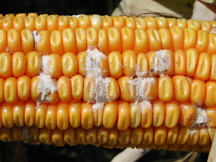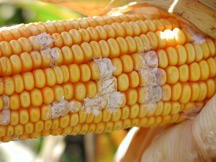
QUICK LINKS
Links to Mycotoxin Info
- Submission guidelines
- Understanding fungal toxins (pdf.)
- Sampling and analyzing feed for fungal toxins (pdf.)
- Use of feed contaminated with fungal toxins (pdf.)
ISU Extension Resources


General Information:
Mycotoxins are secondary metabolites of fungi that are toxic to other life forms. More than 800 mycotoxins have been detected, but relatively few have been characterized and are considered to be important to animal health. There has been a tremendous increase in the ability to detect new and novel mycotoxins in the last few years.
Mycotoxin prevalence and concentration are sporadic and vary annually, even in the same location. Production is affected by local weather patterns, crop damage and productions practices. Mycotoxins may be produced pre- or post-harvest.
Mycotoxins known to occur in Iowa are aflatoxin, fumonisin, vomitoxin, T-2 and zearalenone. They are mostly found in grain, including corn, wheat, milo, rye, and oats. They may be found in silages or other feeds which contain grain.
Health effects:
Since there are many kinds of mycotoxins, which differ from each other, they produce many different kinds of diseases, called mycotoxicoses. They may cause diseases of the liver, gastrointestinal tract, respiratory system, immune system, reproductive system or kidneys. Mycotoxicoses are not contagious.
Effects of the mycotoxins known to occur in Iowa are described in Table 1 below.
Detection of mycotoxins:
Detection of mycotoxins in feeds can aid in the prevention of mycotoxicoses.
Chemical analysis is the best way to find mycotoxins in feed. Screening methods such as ELISA kits are commonly used to rapidly detect mycotoxins. Positive results obtained by most screening methods do not prove the presence of mycotoxins, so positive results should be confirmed using chemical methods.
Screening for mycotoxins in feeds by black light (ultra-violet light) is not always reliable. Detection is based upon the fluorescence of chemicals indicative of the presence of aflatoxin, which occurs when the black light shines on them. Mycotoxins other than aflatoxin do not fluoresce. Chemicals that are not mycotoxins may also fluoresce, causing false positive results
Sampling for analysis:
Mycotoxins are not evenly distributed in feeds. Some areas may contain very high concentrations; other areas may contain no detectable amounts. Detection in feeds depends upon the quality and quantity of sample provided for analysis. The sample should reflect all of the feed available at the time the problem occurred. The longer sample is collected after onset of animal health problems, the more likely the feed from which the sample is collected will not be characteristic of the feed being eaten at the time the problem began. And, the smaller the sample collected and provided for analysis, the more likely mycotoxin contamination will be missed.
Sampling based upon visible presence of molds does not always provide a sample that contains mycotoxins. The presence or absence of visible mold growth are not reliable indicators of the presence or absence of mycotoxins. Very moldy feed may not contain any detectable amounts of know mycotoxins, while good looking feed may contain very high concentrations.
It is best to collect a sample during movement of the feed, like when augering it from the storage bin into a grain truck. Collect small amounts over the entire time the feed is being moved, so that at least 5 pounds, and as much as 10 pounds, have been collected, and mix the collected sample thoroughly. From this large sample randomly select 1 pound in a zip lock bag to submit to the laboratory. Probe sampling may be used. Collect probe samples from as many areas of the feed as practical into a composite sample to select the 1 pound sample from.
Dry samples are preferred for transport to the laboratory. Mold may grow on wet sample, especially if the sample is placed in a plastic bag. Oven-dry specimens to less than 13% moisture for best preservation. Ship sample in a Styrofoam container on ice.
See the ISU VDL User Guide for specific submission guidelines.
Use of mycotoxin-contaminated feeds:
There are legal requirements in regard to mixing or blending mycotoxin contaminated feeds. The Food and Drug Administration (FDA) updated its flooded food guidance on September 17, 2018. Grains are considered food crops and by rule, cannot be used for human or animal food if adulterated.However, for any adulterant there is provision for the holder to ask the FDA to approve a reconditioning plan. In Iowa, the contact point for the FDA is the Iowa Department of Agriculture and Land Stewardship, Feed and Fertilizer Bureau.
TABLE 1: MYCOTOXINS COMMONLY FOUND IN IOWA GRAINS AND THEIR HEALTH EFFECTS
Mycotoxin: Aflatoxins(B1, B2, G1, G2)
Source: Aspergillus flavus, Aspergillus parasiticus
Substance: Grains: corn, milo, cotton seed, peanuts
Conditions favoring production:
- 78°F - 90°F (ideal) down to 55°F
- Kernel damage
- High humidity or grain moisture
Effects:
- Acute: liver toxin, evidence of liver pathology including depression and anorexia
- Chronic: depends upon species, but includes anorexia, poor growth, anemia, ascites, steatorrhea
Remarks:
- The first mycotoxin characterized. More of a problem in states SE of Iowa, especially in the SE part of the US.
- Chronic exposure can produce liver cancer
Mycotoxin: Fumonisins(B1, B2, B3)
Source: Fusarium moniliforme, Fusarium proliferatum
Substance: White & yellow corn
Conditions favoring production:
- Not well defined: Drought during growing season, followed by cool, wet conditions during pollination and development
Effects:
- Horses: equine leukoencephalomalacia (ELE)
- Swine: respiratory syndrome, icterus, weight loss, reduced feed intake
- Ruminants: anorexia and mild weight loss on diets with up to 200 ppm fumonisins, no deaths, no other significant or persistent signs
- Poultry: when consuming feed containing 200 - 400 ppm may develop inappetence and skeletal abnormalities. More resistant than mammals
Mycotoxin: Vomitoxin (deoxynivalenol, DON)
Source: Fusarium roseum
Substance: Corn, milo, wheat, rye, barley, other cereal crops
Conditions favoring production:
- Alternating cool and warm temperatures
- Wet period during flowering
Effects:
- Swine: associated with feed refusal, resulting in decreased weight gain
- Cattle: no apparent adverse health effects
Remarks
- Often occurs with zearalenone
Mycotoxin: Zearalenone
Source: Fusarium roseum (Fusarium graminearum), Fusarium moniliforme
Substance: Corn, wheat, barley, milo, oats
Conditions favoring production:
- High moisture content (> 22%)
- Alternating high and low temperatures during the maturing and harvesting stage (45°F - 70°F)
Effects:
- Functions as a weak estrogen. It does not cause abortions.
- Swine: females, hyperestrogenism, nymphomania; anestrus, pseudopregnancy; immature males, feminization, reduced libido, retarded testicular development; mature males, no effects < 200 ppm
- Cattle: little effects; vaginal secretions, vaginitis, mammary enlargement
Remarks
- Mold infection commonly called “pink ear rot” or “scab”
- Often occurs with DON (deoxynivalenol, vomitoxin)
- Cattle are not very sensitive to zearalenone
